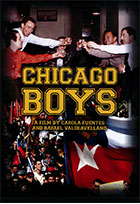
Chicago Boys 2015
Distributed by Icarus Films, 32 Court St., 21st Floor, Brooklyn, NY 11201; 800-876-1710
Produced by Carola Fuentes, Herta Mladinic, and Rafael Valdeavellano
Directed by Carola Fuentes and Rafael Valdeavellano
DVD , color, 85 min.
College - General Adult
Chile, Economics, Latin America, Political Science, South America
Date Entered: 01/27/2017
Reviewed by Susan J. Martin, Head, Acquisitions Services University of ChicagoCarola Fuentes and Rafael Valdeavellano gives us a genuinely interesting behind-the-scenes story of the economic miracle of Chile. Using extensive photographs, historical footage, and current interviews of the players themselves, Chicago Boys tells the story of a group of University of Chicago graduates who return to their native country to Chile where they begin teaching economics at the Pontificia Universidad Católica de Chile (Pontifical Catholic University of Chile). When political change in the form of a military junta comes to the country, several of these professors are called upon by advisors to General Augusto Pinochet to craft an economic policy which become known as El ladrillo (The Brick). After many years under the brutal the leadership of Pinochet, political change comes yet again. Chile begins to prosper economically with the plan put in place by the Chicago boys.
The two Chicago boys that feature most prominently in the film are Sergio de Castro and Rolf Lüders. Both men served in the Pinochet junta as ministers of finance, and de Castro was one of the authors of El Ladrillo. Fuentes extensively interviewed these men, and the film allows the two former finance ministers to freely speak about the implementation of their economic policies by the Pinochet regime. Lüders and de Castro are proud of the “Miracle of Chile” and their part in it.
The Chicago boys pride is starkly contrasted by footage detailing the atrocities committed by the regime on dissenters. When questioned about the atrocities, both men show no empathy, regret, or remorse. They insist that the dictatorship was needed to successfully implement their economic program and that the “Miracle of Chile” could not have happened without it. For Sergio de Castro and Rolf Lüders the end justified the means.
Where the film fails is providing any detailed economic background. We are not given any specifics of El ladrillo, but are left to guess what it contains based on references to Milton Friedman, monetarism, and the Chicago School of neoclassical economic thought. Knowing what was actually done is crucial for any understanding in history. The film reminds us of the brilliance of the Chicago trained Chilean economists, but gives us no examples of the various policy changes they made. We see images and footage of Milton Friedman, but we are never shown precisely which of his concepts were used or modified.
This film sheds a light on an aspect of academic, political and economic history that has received little coverage, and it would serve as an interesting supplement and discussion piece on the issues of economics and human rights. It is recommended with reservations as the film does not provide sufficient background on or explanation of the economic theories for a novice to comfortably view and understand.